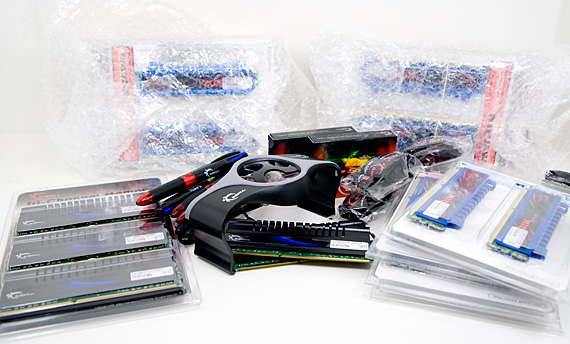

We discussed the availability of AMD branded memory modules earlier this month, but today AMD is officially unveiling information on their memory platform. There are a few major questions many will have: why is AMD entering the memory market at all, and what do they hope to offer that we ...

Intel's Second Generation Core processors, based on the Sandy Bridge architecture, include a number of improvements over the previous generation's Nehalem architecture. We’ll be testing one specific area today: the improved memory controller. Current Sandy Bridge based processors officially support up to DDR3-1333 memory. Unfortunately, due to changes in the architecture, using faster rated memory (or overclocking memory) on Sandy Bridge via raising the base clock is extremely limited. Luckily, there are additional memory multipliers that support DDR3-1600, DDR3-1866, and DDR3-2133 memory. Some motherboards include support for even higher memory multipliers, but we’ll confine our investigations to DDR3-2133 and below.
Since Sandy Bridge is rated for up to DDR3-1333 memory, we will start there and work our way up to DDR3-2133 memory. We'll also be testing a variety of common CAS latency options for these memory speeds. Our purpose is to show how higher bandwidth memory affects performance on Sandy Bridge, and how latency changes—or doesn’t change—the picture. More specifically, we’ll be looking at the impact of memory speed on application and gaming performance, with some synthetic memory tests thrown into the mix. We’ll also test some overclocked configurations. So how much difference will lowering the CAS latency make, and does memory performance scale with processor clock speed? Read on to find out.


Patriot gave me a preview of their new Viper Xtreme Division4 DDR3 memory due out later this year. Patriot is targeting this new line at Sandy Bridge E systems, which support up to four channels of DDR3 memory (official support for DDR3-1600, but overclocking will surely be an option). Given the ...
It started off as a simple enough memory review, but somewhere along the way we decided to dramatically expand the scope of our discussion and avoid the monotony of a typical memory piece. The end result? An in-depth look at some of the more fundamental aspects of SDRAM operation. If you'd like to expand your understanding of memory transaction minutia while learning more about which key performance factors need to be tuned and why, then have we got the article for you! Set some good time aside, grab a tall mug of your favorite, frosty beverage, and prepare for an exercise in reasoning. You're not going to want to miss what we have to share.
The whole 'fastest memory' halo product race is a bit of a farce. In terms of DDR3, Corsair started the race back in 2007 with their first set of Dominator modules, running at 1600Mhz, 10-8-8-24. This has been followed and bested, mainly by Corsair, but with sneak appearances by Kingston, G.Skill and Patriot (see below).
Available as single sticks from the Corsair website, these new GTX4 modules will set you back $325 for each 2GB stick. With rather slack timings of 9-11-10-30 at 1.65V, each module is handtested using a Core i7 Lynnfield CPU on a Gigabyte P55 motherboard. Michal Nowicki, Corsair's inhouse overclocker, advises that 'most CPUs will require sub-ambient cooling to run [these modules] at their maximum speed'.
Despite the lifetime warranty and the ability to boast about a 'halo' product, I can't see a point in these sticks - even for overclockers. With such slack timings to begin with, I wonder just how much headroom is available, when other 2400+ kits with better timings are available. At $325 a stick, you really are shooting yourself in the foot.
Before the new site launched I demoed a new feature I'd been toying with called This Just In. The idea is to give you guys a quick glance at what I'm working on (and eventually what the entire team is working on) as soon as something new arrives at our doorsteps.
I'll admit that there have been a few things that have arrived since my last post, however all of them are under NDA at this point. I do have good news though, more giveaways are coming.
I asked our ad reps to see if any of their clients wanted to provide any giveaways to commemorate the new site launch. G.Skill was eager to show their appreciation for you all and dropped off a big box of goodies to give away.
I haven't inventoried it all yet, nor have I decided how we're going to give it away but expect more details next week :) And congrats to our AMD/Lenovo giveaway winner Scott T. from Syracuse, NY. Scott and I have already been in communication and AMD is working hard to get him his brand new ThinkPad X100e asap!
We take a look at the latest DDR3-2000+ kits from Corsair and OCZ, but find the quality of the Elpida Hyper ICs is the real story.
We take an in-depth look at memory scaling on the Core i7 platform to determine if there is any value in using memory faster than DDR3-1066.
We take our first look at OCZ's new 3B2133LV6GK DDR3-2133 kit and realize we need to call in the big guns for benchmarking at 2133MHz and beyond.
We take a first look at a very impressive DDR3-1333 (PVT36G1333ELK) 6GB memory kit from Patriot and figure out our assumptions about inexpensive DDR3 memory were misguided.
Actually, high VDimm is a problem but only under certain circumstances. How and why is something we cannot answer yet, but we do have a briefing today.






